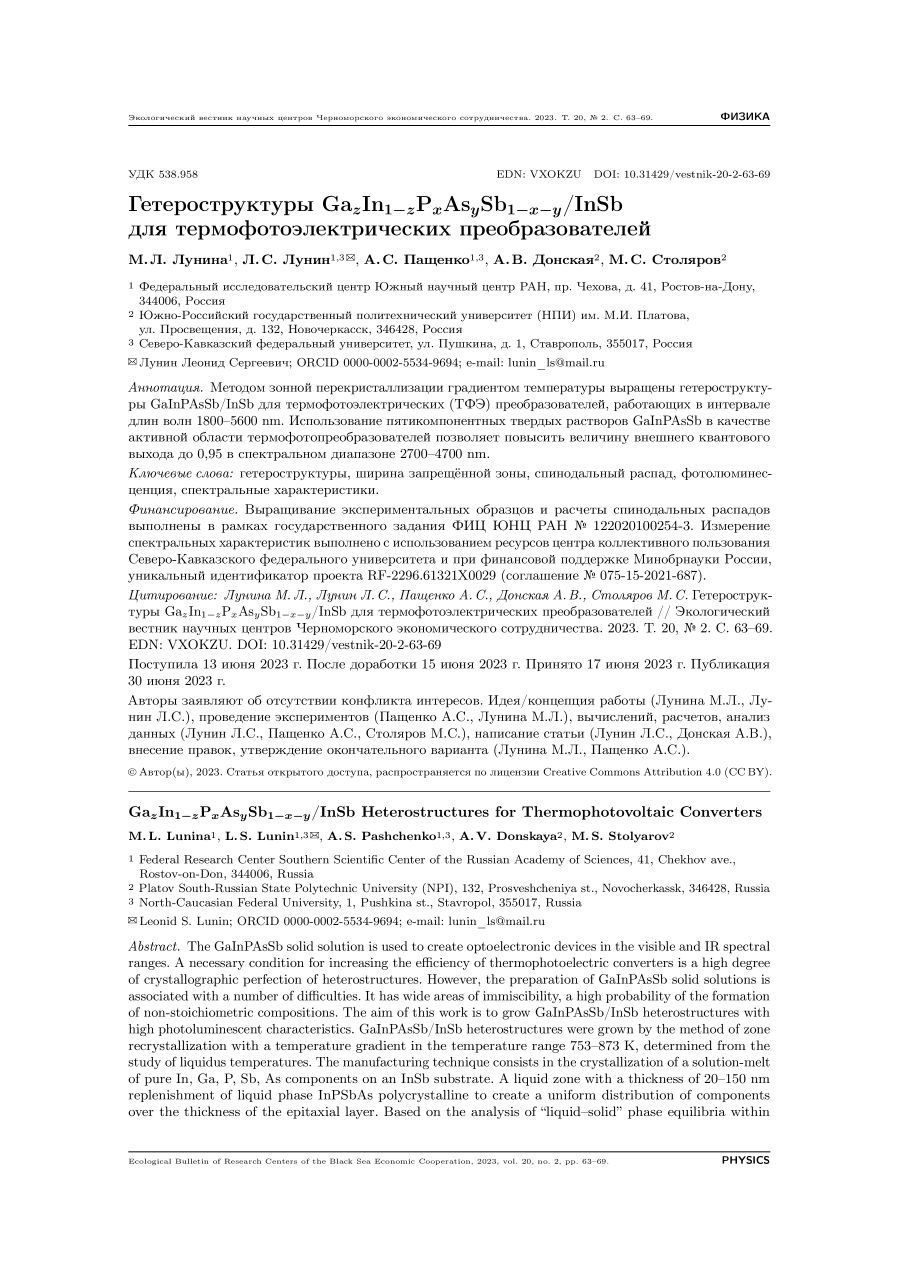GazIn1-zPxAsySb1-x-y/InSb heterostructures for thermophotovoltaic converters
UDC
538.958DOI:
https://doi.org/10.31429/vestnik-20-2-63-69Abstract
The GaInPAsSb solid solution is used to create optoelectronic devices in the visible and IR spectral ranges. A necessary condition for increasing the efficiency of thermophotoelectric converters is a high degree of crystallographic perfection of heterostructures. However, the preparation of GaInPAsSb solid solutions is associated with a number of difficulties. It has wide areas of immiscibility, a high probability of the formation of non-stoichiometric compositions. The aim of this work is to grow GaInPAsSb/InSb heterostructures with high photoluminescent characteristics. GaInPAsSb/InSb heterostructures were grown by the method of zone recrystallization with a temperature gradient in the temperature range 753-873 K, determined from the study of liquidus temperatures. The manufacturing technique consists in the crystallization of a solution-melt of pure In, Ga, P, Sb, As components on an InSb substrate. A liquid zone with a thickness of 20-150 nm replenishment of liquid phase InPSbAs polycrystalline to create a uniform distribution of components over the thickness of the epitaxial layer. Based on the analysis of "liquid-solid" phase equilibria within the framework of the simple solution model, the technological parameters of the heteroepitaxial growth of GaInPAsSb solid solutions in the composition range $0.01\le x\le 0.30$, $0.01\le y\le 0.45$, $0.01\le z\le 0.60$. With an increase in the concentration of phosphorus in the solid solution, the mismatch in the lattice periods of the layer and substrate $\delta a$ increases. However, the mismatch between the lattice periods of the substrate and the solid solution layer by a value of $\delta a\ge 0.0$% causes stresses at the heterointerface, which prevent spinodal decomposition, increasing the region of existence of GaInPAsSb solutions. The photoluminescence spectra of GaInAsSb/InSb and GaInPAsSb/InSb heterostructures are compared with the active region in the layer. It is shown that the addition of phosphorus to GaInAsSb leads to an increase in the intensity and a decrease in the emission bandwidth at half the height of the peaks. This indicates an improvement in the crystalline properties of the films. As a result, the use of five-component GaInPAsSb solid solutions as the active area of thermophotoelectric converters makes it possible to increase the external quantum efficiency to 0.95 in the spectral range 2700-4700 nm.
Keywords:
heterostructures, band gap, spinodal decomposition, photoluminescence, spectral characteristicsAcknowledgement
References
- Malevskaya, A.V., Kalyuzhnyy, N.A., Malevskii, D.A., Mintairov, S.A., Nakhimovich, M.V., Soldatenkov, F.Y., Shvarts, M.Z., Andreev, V.M., Nadtochiy, A.M., Infrared (850 nm) light-emitting diodes with multiple InGaAs quantum wells and "back" reflector. Semiconductors, 2021, vol. 55, pp. 686–690. DOI: 10.1134/S1063782621080121
- Малевская, А.В., Калюжный, Н.А., Минтаиров, С.А., Салий, Р.А., Малевский, Д.А., Нахимович, М.В., Ларионов, В.Р., Покровский, П.В., Шварц, М.З., Андреев, В.М., Высокоэффективные (EQE=37.5%) инфракрасные (850 нм) светодиоды с брэгговским и зеркальным отражателями. Физика и техника полупроводников, 2021, т. 55, № 12, с. 1218–1222. [Malevskaya, A.V., Kalyuzhnyy, N.A., Mintairov, S.A., Salii, R.A., Malevskii, D.A., Nakhimovich, M.V., Larionov, V.R., Pokrovskii, P.V., Shvarts, M.Z., Andreev, V.M., High efficiency (EQE=37.5%) infrared (850 nm) light-emitting diodes with bragg and mirror reflectors. Semiconductors, 2021, vol. 55, no. 12, pp. 1218–1222. (in Russian)] DOI: 10.21883/FTP.2021.12.51709.9711
- Lang, R., Schön, J., Lefèvre, J., Boizot, B., Dimroth, F., Lackner, D., Radiation hardness and post irradiation regeneration behavior of GaInAsP solar cells. Solar Energy Materials and Solar Cells, 2020, vol. 211, pp. 110551–11057. DOI: 10.1016/j.solmat.2020.110551
- Khvostikov, V.P., Pokrovskii, P.V., Khvostikova, O.A., Pan'chak, A.N., Andreev, V.M., High-efficiency AlGaAs/GaAs photovoltaic converters with edge input of laser light. Technical Physics Letters, 2018, vol. 44, no. 9, pp. 776–778. DOI: 10.1134/S1063785018090079
- Потапович, Н.С., Нахимович, М.В., Хвостиков, В.П., Фотоэлектрические преобразователи узкополосного излучения на основе гетероструктур InGaAsP/InP. Физика и техника полупроводников, 2021, т. 55, №11, с. 1091–1094. [Potapovich, N.S., Nakhimovich, M.V., Khvostikov, V.P., InGaAsP/InP photovoltaic converters for narrow-band radiation. Semiconductors, 2021, vol. 55, no. 11, pp. 1091–1094. (in Russian)] DOI: 10.21883/FTP.2021.11.51566.9688
- Liu, R., Shterengas, L., Stein, A., Kipshidze, G., Zakharov, D., Kisslinger, K., Belenky, G.L., Photonic crystal surface emitting diode lasers with λ near 2 μm. Photonics, 2022, vol. 9, no. 12, pp. 891–898. DOI: 10.3390/photonics9120891
- Cheng, H., Lin, S., Li, Z., Sun, K., Lee, C., PCSEL performance of type-I InGaAsSb double-QWs laser structure prepared by MBE. Materials, 2019, vol. 12, no. 2, pp. 317–326. DOI: 10.3390/ma12020317
- Gastellóu, E., García, R., Herrera, A.M., Ramos, A., García, G., Robles, M., Rodríguez, J.A., Ramírez, Y.D., Carrillo, R.C., Isotherm theoretical study of the AlxGa1-xAsySb1-y quaternary alloy using the regular solution approximation for its possible growth via liquid-phase epitaxy at low temperatures. Entropy, 2022, vol. 24, no. 12, pp. 1711–1718. DOI: 10.3390/e24121711
- Айдаралиев, М., Зотова, Н.В., Карандашев, С.А., Матвеев, Б.А., Ременный, М.А., Стусь, Н.М., Талалакин, Г.Н., Шустов, В.В., Кузнецов, В.В., Когновицкая, Е.А., Изопериодные структуры GaInPAsSb/InAs для приборов инфракрасной оптоэлектроники. Физика и техника полупроводников, 2002, т. 36, №8, с. 1010–1015. [Aydaraliev, M., Zotova, N.V., Karandashov, S.A., Matveev, B.A., Remennyi, M.A., Stus', N.M., Talalakin, G.N., Kuznetsov, V.V., Kognovitskaya, E.A., GaInPAsSb/InAs isoperiodic structures for infrared optoelectronic devices. Semiconductors, 2002, vol. 36, no. 8, pp. 1010–1015. (in Russian)]
- Алфимова, Д.Л., Лунин, Л.С., Лунина, М.Л., Пащенко, А.С., Чеботарев, С.Н., Выращивание и свойства изопериодных твердых растворов GaInPSbAs на подложках арсенида индия. Физика твердого тела, 2016, т. 58, №9, с. 1695–1700. [Alfimova, D.L., Lunin, L.S., Lunina, M.L., Pashchenko, A.S., Chebotarev, S.N., Growth and properties of isoperiod GaInPSbAs solid solutions on indium arsenide substrates. Physics of the Solid State, 2016, vol. 58, no. 9, pp. 1695–1070. (in Russian)]
- Лунин, Л.С., Лунина, М.Л., Алфимова, Д.Л., Пащенко, А.С., Пащенко, О.С., Морфология и структурные свойства эпитаксиальных пленок AlGaInSbAs, выращенных на подложках InAs. Поверхность. Рентгеновские, синхротронные и нейтронные исследования, 2021, т. 33, №5, с. 33–41. [Lunin, L.S., Lunina, M.L., Alfimova, D.L., Pashchenko, A.S., Pashchenko, O.S., Morphology and structural properties of AlGaInSbAs epitaxial films grown on InAs substrates. Journal of surface investigation: X-Ray, synchrotron and neutron techniques, 2021, vol. 33, no. 5, pp. 33–41. (in Russian)] DOI: 10.31857/S1028096021050137
Downloads
Submitted
Published
How to Cite
Copyright (c) 2023 Lunina M.L., Lunin L.S., Pashchenko A.S., Donskaya A.V., Stolyarov M.S.

This work is licensed under a Creative Commons Attribution 4.0 International License.




